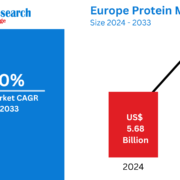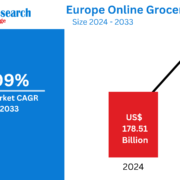Automotive Lighting Market : Forecast 2025–2033: Trends, Segmentation, and Strategic Insights
Global Automotive Lighting Market to Reach US$ 58.80 Billion by 2033: Renub Research
Renub Research has released its latest industry analysis titled “Automotive Lighting Market Size, Share, Growth Trends & Forecast 2025–2033”. The global automotive lighting market is projected to grow from US$ 34.60 billion in 2024 to US$ 58.80 billion by 2033, exhibiting a healthy CAGR of 6.07% during the forecast period.
This growth is primarily fueled by rising global vehicle production, increased demand for energy-efficient and sustainable lighting technologies, and a heightened focus on safety and aesthetics in modern vehicles. Innovations in LED, OLED, and adaptive lighting systems are revolutionizing the way manufacturers approach automotive lighting solutions.
🔍 Key Market Highlights:
- Technological Advancements: The market is witnessing rapid adoption of LED, matrix lighting, adaptive front lighting systems, and laser technologies.
- Safety-Driven Demand: Regulatory pressure and consumer awareness are encouraging automakers to adopt advanced lighting systems to reduce road accidents and enhance visibility.
- Sustainability Trends: Global environmental initiatives are pushing OEMs and aftermarket suppliers to switch to low-energy, eco-friendly lighting components.
🚗 Segment-Wise Insights:
- By Vehicle Type: Passenger vehicles dominate the market due to surging demand for stylish and safe lighting. The rise of EVs and autonomous cars is pushing for more smart lighting integrations.
- By Application: Front lighting leads in revenue generation, while interior ambient lighting is gaining strong traction, especially in luxury vehicles.
- By Technology: While halogen remains significant in price-sensitive regions, LED and laser lighting are fast replacing legacy systems.
- By Sales Channel: OEMs account for a larger share, but the aftermarket is booming with vehicle customization and retrofitting trends.
🌍 Country-Level Outlook:
- United States: Rising EV adoption, luxury car sales, and advanced safety mandates are driving growth.
- Germany: A global hub for automotive R&D, the country leads in innovation and adoption of premium lighting technologies.
- India: Strong market growth supported by increasing production and government incentives for EVs and safety standards.
- Brazil & Saudi Arabia: Both show promising growth through infrastructure development, rising vehicle ownership, and OEM expansions.
“Automotive lighting is not just about visibility—it’s about safety, energy efficiency, and brand identity. The shift to LED, adaptive, and ambient systems is transforming the driving experience,” said a spokesperson at Renub Research.
🧩 Key Players Profiled:
- ams OSRAM
- Nichia Corporation
- FORVIA HELLA
- OLEDWorks
- Samsung Electronics
- Texas Instruments
- Panasonic Corporation, and more.
📘 Report Coverage:
The report provides a comprehensive analysis covering:
- Market drivers, restraints, and opportunities
- Segment-wise market estimates (Vehicle Type, Technology, Application, Channel)
- Country-wise breakdown across North America, Europe, APAC, Latin America, and MEA
- Company profiling, revenue analysis, strategic developments, and partnerships
🆓 Get a Free Sample Report Now:
👉 Download Sample
For media inquiries, interviews, or further insights:
📧 info@renub.com | 📞 +91-120-421-9822
New Publish Reports
- China Hydroponics Market Report by Type (Aggregate Systems, Liquid Systems), Crop Type (Tomatoes, Herbs, Lettuce, Cucumbers, Peppers, Others), Equipment (HVAC, LED Grow Light, Irrigation Systems, Material Handling, Control Systems, Others), Region and Company 2025-2033
- France Hydroponics Market Report by Type (Aggregate Systems, Liquid Systems), Crop Type (Tomatoes, Herbs, Lettuce, Cucumbers, Peppers, Others), Equipment (HVAC, LED Grow Light, Irrigation Systems, Material Handling, Control Systems, Others), Region and Company 2025-2033
- Germany Hydroponics Market Report by Type (Aggregate Systems, Liquid Systems), Crop Type (Tomatoes, Herbs, Lettuce, Cucumbers, Peppers, Others), Equipment (HVAC, LED Grow Light, Irrigation Systems, Material Handling, Control Systems, Others), Region and Company 2025-2033
❓Frequently Asked Questions (FAQs)
Q1. What is the projected size of the automotive lighting market by 2033?
A: The automotive lighting market is expected to reach US$ 58.80 billion by 2033, growing from US$ 34.60 billion in 2024.
Q2. What is driving growth in the automotive lighting industry?
A: Key growth drivers include:
- Increased vehicle production and sales
- Rising demand for LED and adaptive lighting
- Stringent safety and emission regulations
- Consumer preference for stylish, energy-efficient lighting systems
Q3. Which vehicle type leads the automotive lighting market?
A: Passenger vehicles hold the largest market share, driven by rising EVs, urbanization, and advanced driver-assistance systems (ADAS).
Q4. How is LED technology impacting the market?
A: LEDs are revolutionizing automotive lighting due to:
- Low energy consumption
- Long lifespan
- Better design flexibility
- Integration with smart vehicle systems
Q5. What are the major challenges faced by the market?
A:
- High initial costs of advanced lighting systems (LED, laser)
- Raw material shortages and supply chain disruptions
- Affordability issues in price-sensitive markets
Q6. Which regions are seeing the fastest growth?
A:
- Asia Pacific (India, China, Japan): Vehicle production and EV adoption
- North America: Safety standards and premium vehicle sales
- Middle East & Brazil: Infrastructure and OEM expansions
Q7. Who are the leading players in the global automotive lighting market?
A: Notable players include ams OSRAM, Nichia, Samsung Electronics, Panasonic, Texas Instruments, and OLEDWorks among others.
Q8. What role do OEMs play in this market?
A: OEMs dominate due to their:
- Integration of lighting systems into vehicle design
- Innovations in intelligent and adaptive lighting
- Strong partnerships with auto manufacturers
Q9. What are the emerging trends in the interior lighting market?
A:
- Ambient lighting, customizable colors, and infotainment-linked systems
- Demand is surging in premium segments for luxury and comfort
Q10. How does this market align with EV growth?
A: EVs require modern, energy-efficient lighting. As EV sales rise, so does the need for intelligent, lightweight, and stylish liGlobal Automotive Lighting Market to Reach US$ 58.80 Billion by 2033: Renub Research
Renub Research has released its latest industry analysis titled “Automotive Lighting Market Size, Share, Growth Trends & Forecast 2025–2033”. The global automotive lighting market is projected to grow from US$ 34.60 billion in 2024 to US$ 58.80 billion by 2033, exhibiting a healthy CAGR of 6.07% during the forecast period.
This growth is primarily fueled by rising global vehicle production, increased demand for energy-efficient and sustainable lighting technologies, and a heightened focus on safety and aesthetics in modern vehicles. Innovations in LED, OLED, and adaptive lighting systems are revolutionizing the way manufacturers approach automotive lighting solutions.
🔍 Key Market Highlights:
- Technological Advancements: The market is witnessing rapid adoption of LED, matrix lighting, adaptive front lighting systems, and laser technologies.
- Safety-Driven Demand: Regulatory pressure and consumer awareness are encouraging automakers to adopt advanced lighting systems to reduce road accidents and enhance visibility.
- Sustainability Trends: Global environmental initiatives are pushing OEMs and aftermarket suppliers to switch to low-energy, eco-friendly lighting components.
🚗 Segment-Wise Insights:
- By Vehicle Type: Passenger vehicles dominate the market due to surging demand for stylish and safe lighting. The rise of EVs and autonomous cars is pushing for more smart lighting integrations.
- By Application: Front lighting leads in revenue generation, while interior ambient lighting is gaining strong traction, especially in luxury vehicles.
- By Technology: While halogen remains significant in price-sensitive regions, LED and laser lighting are fast replacing legacy systems.
- By Sales Channel: OEMs account for a larger share, but the aftermarket is booming with vehicle customization and retrofitting trends.
🌍 Country-Level Outlook:
- United States: Rising EV adoption, luxury car sales, and advanced safety mandates are driving growth.
- Germany: A global hub for automotive R&D, the country leads in innovation and adoption of premium lighting technologies.
- India: Strong market growth supported by increasing production and government incentives for EVs and safety standards.
- Brazil & Saudi Arabia: Both show promising growth through infrastructure development, rising vehicle ownership, and OEM expansions.
“Automotive lighting is not just about visibility—it’s about safety, energy efficiency, and brand identity. The shift to LED, adaptive, and ambient systems is transforming the driving experience,” said a spokesperson at Renub Research.
🧩 Key Players Profiled:
- ams OSRAM
- Nichia Corporation
- FORVIA HELLA
- OLEDWorks
- Samsung Electronics
- Texas Instruments
- Panasonic Corporation, and more.
📘 Report Coverage:
The report provides a comprehensive analysis covering:
- Market drivers, restraints, and opportunities
- Segment-wise market estimates (Vehicle Type, Technology, Application, Channel)
- Country-wise breakdown across North America, Europe, APAC, Latin America, and MEA
- Company profiling, revenue analysis, strategic developments, and partnerships
🆓 Get a Free Sample Report Now:
👉 Download Sample
For media inquiries, interviews, or further insights:
📧 info@renub.com | 📞 +91-120-421-9822
New Publish Reports
- China Hydroponics Market Report by Type (Aggregate Systems, Liquid Systems), Crop Type (Tomatoes, Herbs, Lettuce, Cucumbers, Peppers, Others), Equipment (HVAC, LED Grow Light, Irrigation Systems, Material Handling, Control Systems, Others), Region and Company 2025-2033
- France Hydroponics Market Report by Type (Aggregate Systems, Liquid Systems), Crop Type (Tomatoes, Herbs, Lettuce, Cucumbers, Peppers, Others), Equipment (HVAC, LED Grow Light, Irrigation Systems, Material Handling, Control Systems, Others), Region and Company 2025-2033
- Germany Hydroponics Market Report by Type (Aggregate Systems, Liquid Systems), Crop Type (Tomatoes, Herbs, Lettuce, Cucumbers, Peppers, Others), Equipment (HVAC, LED Grow Light, Irrigation Systems, Material Handling, Control Systems, Others), Region and Company 2025-2033
❓Frequently Asked Questions (FAQs)
Q1. What is the projected size of the automotive lighting market by 2033?
A: The automotive lighting market is expected to reach US$ 58.80 billion by 2033, growing from US$ 34.60 billion in 2024.
Q2. What is driving growth in the automotive lighting industry?
A: Key growth drivers include:
- Increased vehicle production and sales
- Rising demand for LED and adaptive lighting
- Stringent safety and emission regulations
- Consumer preference for stylish, energy-efficient lighting systems
Q3. Which vehicle type leads the automotive lighting market?
A: Passenger vehicles hold the largest market share, driven by rising EVs, urbanization, and advanced driver-assistance systems (ADAS).
Q4. How is LED technology impacting the market?
A: LEDs are revolutionizing automotive lighting due to:
- Low energy consumption
- Long lifespan
- Better design flexibility
- Integration with smart vehicle systems
Q5. What are the major challenges faced by the market?
A:
- High initial costs of advanced lighting systems (LED, laser)
- Raw material shortages and supply chain disruptions
- Affordability issues in price-sensitive markets
Q6. Which regions are seeing the fastest growth?
A:
- Asia Pacific (India, China, Japan): Vehicle production and EV adoption
- North America: Safety standards and premium vehicle sales
- Middle East & Brazil: Infrastructure and OEM expansions
Q7. Who are the leading players in the global automotive lighting market?
A: Notable players include ams OSRAM, Nichia, Samsung Electronics, Panasonic, Texas Instruments, and OLEDWorks among others.
Q8. What role do OEMs play in this market?
A: OEMs dominate due to their:
- Integration of lighting systems into vehicle design
- Innovations in intelligent and adaptive lighting
- Strong partnerships with auto manufacturers
Q9. What are the emerging trends in the interior lighting market?
A:
- Ambient lighting, customizable colors, and infotainment-linked systems
- Demand is surging in premium segments for luxury and comfort
Q10. How does this market align with EV growth?
A: EVs require modern, energy-efficient lighting. As EV sales rise, so does the need for intelligent, lightweight, and stylish lighting solutions.ghting solutions.






